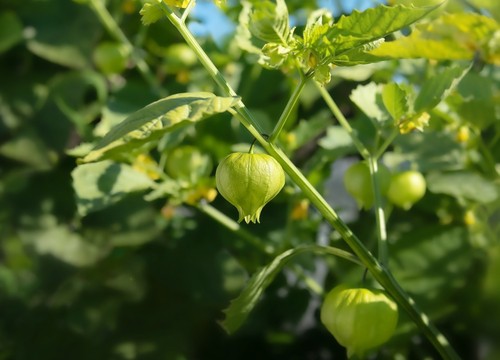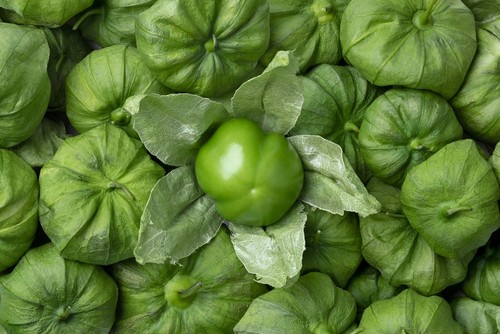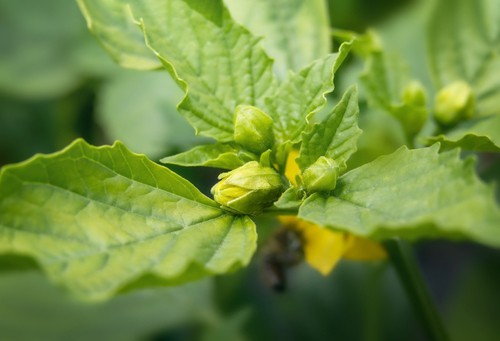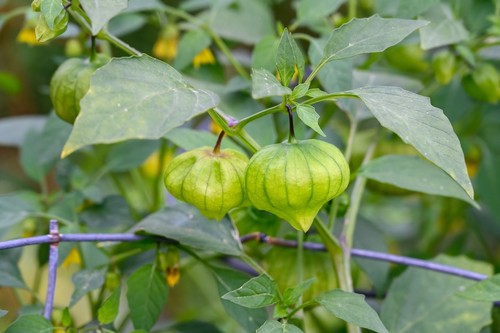Tomatillos are a staple in Mexican cuisine and are often used to make salsa verde. If you are growing your own tomatillos, you might notice tomatillos turning yellow and falling off. This can be concerning, especially if you are not sure what is causing it.
Understanding tomatillo plants is the first step in determining why they are turning yellow and falling off. Tomatillos are closely related to tomatoes and have similar growing requirements. They prefer full sun and well-draining soil. They are also susceptible to pests and diseases like aphids, spider mites, and powdery mildew.
Key Takeaways
- Tomatillos turning yellow and falling off can be a sign of maturity and nearing ripeness.
- Common causes include lack of water and sunlight, nutrient deficiencies, pests and diseases, and overwatering.
- Preventive measures include proper watering and fertilization, pest and disease control, and harvesting at the right time.
Similar posts:
Understanding Tomatillo Plants

Tomatillos are a staple in Mexican cuisine, and they are becoming increasingly popular in gardens around the world. These small, green fruits are members of the nightshade family, and they are closely related to tomatoes.
However, tomatillos have a unique flavor that is tangy and slightly sour, making them a popular ingredient in salsas, sauces, and stews.
Tomatillo plants are relatively easy to grow, and they are generally low-maintenance. They are annual plants, meaning that they complete their life cycle in one growing season. They can grow up to 4 feet tall and 3 feet wide, and they produce fruit throughout the growing season.
Tomatillo plants are self-incompatible, meaning that they need to be cross-pollinated by another tomatillo plant in order to produce fruit.
The fruit of the tomatillo plant is typically green and covered in a papery husk. As the fruit matures, the husk begins to turn yellow or brown, and the fruit itself may also turn yellow. This is a natural part of the ripening process, and it indicates that the fruit is ready to be harvested.
However, if the fruit is turning yellow prematurely or falling off the plant before it is fully ripe, there may be an underlying issue that needs to be addressed.
Tomatillos come in a variety of colors and sizes, and some varieties may be more prone to yellowing or falling off the plant than others. It is important to choose a variety that is well-suited to your garden and growing conditions in order to ensure a healthy and productive harvest.
Symptoms of Yellowing and Falling Off
Tomatillos turning yellow and falling off can be a sign of various issues affecting the plant. Some common symptoms of yellowing and falling off include:
- Yellowing Leaves: One of the most noticeable symptoms of tomatillos turning yellow and falling off is the yellowing of leaves. The leaves may turn yellow from the edges or tips and gradually spread towards the center of the leaf.
- Brown Leaves: In addition to yellowing, the leaves may also turn brown and dry out. This may be a sign of a more severe problem, such as a pest infestation or fungal disease.
- Dropping Fruit: Another symptom of tomatillos turning yellow and falling off is the dropping of fruit. The fruit may fall off prematurely or fail to develop properly, leading to a reduced yield.
There are several possible causes of tomatillos turning yellow and falling off, including inadequate water or nutrients, pests and diseases, overripe fruit, or physical damage. Stress factors such as extreme temperatures or drought can also cause premature fruit drop.
It is important to identify the specific cause of yellowing and falling off in order to determine the best course of action to prevent further fruit loss. This may involve adjusting watering or fertilization practices, treating pests or diseases, or providing shade or protection from extreme temperatures.
In some cases, it may be necessary to remove and dispose of infected or damaged plants to prevent the spread of disease.
Tomatillos Turning Yellow and Falling Off – 4 Common Problems

Tomatillos are a popular and nutritious addition to many dishes, but they can be frustrating to grow if the fruit starts to turn yellow and fall off the plant before it is ready to be harvested.
There are several common causes of this problem, including water-related issues, nutrient deficiencies, temperature and humidity factors, and pest and disease problems.
1. Water-Related Issues
One of the most common causes of tomatillo fruit turning yellow and falling off is a lack of water. Tomatillos need consistent moisture to thrive, and if they do not get enough water, they will start to wilt and the fruit will turn yellow and fall off.
Overwatering can also be a problem, as it can lead to root rot and other fungal infections that can cause the fruit to drop prematurely.
2. Nutrient Deficiencies
Tomatillos require a variety of nutrients to grow and develop properly, and if they are not getting enough of these nutrients, the fruit may turn yellow and fall off. Common nutrient deficiencies that can cause this problem include a lack of nitrogen, phosphorus, and potassium.
Gardeners can address these deficiencies by using a balanced fertilizer or adding compost to the soil.
3. Temperature and Humidity Factors
Extreme temperatures and humidity can also cause tomatillo fruit to turn yellow and fall off prematurely. If the temperature is too hot or too cold, the plant may become stressed and start to drop fruit.
Similarly, if the humidity is too high or too low, the plant may struggle to absorb nutrients and water, which can cause the fruit to turn yellow and fall off.
4. Pest and Disease Problems
Several pests and diseases can also cause tomatillo fruit to turn yellow and fall off. Common pests that can cause this problem include aphids, psyllid yellows, whiteflies, and spider mites.
These pests can suck the sap from the plant, which can cause the fruit to drop prematurely. Common diseases that can cause this problem include early blight and powdery mildew. These diseases can cause the leaves and fruit to turn yellow and fall off.
Preventive Measures and Solutions

1. Proper Watering and Fertilization
Tomatillos require consistent moisture to grow properly. Overwatering or underwatering can cause the leaves to turn yellow and fall off. A good practice is to water deeply once or twice a week and monitor the soil moisture level regularly.
Make sure the soil is moist but not soggy. Proper fertilization is also important. A balanced fertilizer with equal amounts of nitrogen, phosphorus, and potassium is recommended. Compost can be added to the soil to provide additional nutrients.
2. Pruning and Harvesting
Pruning can help to improve air circulation and prevent the spread of diseases. Remove any dead or yellow leaves and stems. Prune the plant to remove any branches that are touching the ground. This will prevent pests and diseases from spreading.
Harvesting tomatillos at the right time is also important. Wait until the fruit has filled out the husk and the husk has turned brown and papery. Harvest the fruit by gently twisting it off the plant.
3. Choosing the Right Location
Choosing the right location for tomatillos is important. They require full sun to grow properly. Make sure to plant them in an area that receives at least 6 hours of direct sunlight per day. They also require well-drained soil. If the soil is too wet, the roots can rot.
4. Dealing with Pests and Diseases
Several pests and diseases can cause tomatillos to turn yellow and fall off the plant. Aphids can cause leaves to turn yellow and distort. Control aphids using insecticidal soaps or a strong stream of water.
Spider mites can also be a problem. They can cause yellowing of the leaves and a fine webbing on the plant. Control spider mites using neem oil or insecticidal soap. Nutrient deficiencies can also cause yellowing of the leaves. Nitrogen deficiency is a common problem. Add a nitrogen-rich fertilizer to the soil to correct this issue.
Understanding Tomatillo Ripening and Harvesting

Tomatillos are a staple in Mexican cuisine and are commonly used in salsas, sauces, and stews. Like other fruits, tomatillos go through a ripening process, and it’s important to know when to harvest them to get the best flavor.
1. Ripening Process
Tomatillos start off green and will gradually turn yellow or purple as they ripen. However, unlike other fruits, tomatillos do not turn red when they’re ripe. Instead, the fruit will be bright green, and the husk may turn a brownish color.
Yellow or purple tomatillos usually indicate over-ripeness or a different flavor. The main exception is for purple or yellow heirloom tomatillo varieties.
Fully ripe tomatillos will be firm and have a slightly sweet, tangy flavor. Overripe fruit will be soft and mushy, and the flavor will be more acidic. It’s important to pick tomatillos at the right time to get the best flavor.
2. Harvesting
Tomatillo harvesting is best when the fruits are green because they contain the most flavor. It’s important to know how to harvest tomatillos to enhance continued fruiting. Here are the steps for harvesting tomatillos:
- Check the size of the tomatillo. The fruit should be about 1 to 2 inches in diameter.
- Check the color of the fruit and husk. The fruit should be bright green, and the husk should be tight and papery.
- Use scissors or pruners to cut the fruit from the plant. Be sure to leave a bit of stem attached to the fruit.
- Discard any moldy or damaged fruit.
After harvesting, tomatillos can be stored in the refrigerator for up to two weeks. To store them for longer, you can freeze them or can them for later use.
3. Maturity
Tomatillos are ready to harvest when they reach maturity. This is usually around 75 to 100 days after planting, depending on the variety. You can tell when a tomatillo is mature by checking the size and color of the fruit and the firmness of the fruit.
4. Edible
Tomatillos are edible both raw and cooked. They have a slightly sweet, tangy flavor and are commonly used in Mexican cuisine. They can be eaten raw in salads or salsas, or cooked in stews, sauces, and casseroles.
Potential Impact on Yield and Plant Health

Tomatillos turning yellow and falling off prematurely can have a significant impact on the yield and health of the plant. If left unaddressed, this issue can lead to poor yields and a weakening of the bush, which can ultimately affect the overall health of the plant.
One of the main causes of tomatillos turning yellow is stress, which can be caused by a variety of factors including overwatering, underwatering, poor soil quality, and extreme temperatures. When the plant is stressed, it may drop its fruit prematurely in an effort to conserve energy.
Another factor that can impact the yield and health of the plant is magnesium deficiency. This can cause yellow spots on the leaves and can also lead to the premature dropping of fruit. To address this issue, growers can fertilize their plants with a magnesium-rich fertilizer or add Epsom salt to the soil.
In addition to stress and magnesium deficiency, the presence of pests or diseases can also impact the health of the plant and its yield. Growers can prevent this by using a cage or other support system to keep the plant off the ground and by regularly inspecting the plant for signs of pests or diseases.
Frequently Asked Questions
Why are my tomatillo fruit turning yellow and falling off?
Tomatillo fruit can turn yellow and fall off due to a variety of reasons, including overwatering, underwatering, pests, diseases, and nutrient deficiencies. It is important to identify the underlying cause and take appropriate measures to prevent further damage.
Why are my tomatillos turning yellow?
Tomatillos can turn yellow due to a variety of reasons, including overwatering, underwatering, nutrient deficiencies, pests, diseases, and environmental stress. It is important to identify the underlying cause and take appropriate measures to prevent further damage.
Are tomatillos still good when they turn yellow?
Tomatillos are still good when they turn yellow, but they may not be as ripe as they could be. Fully ripe tomatillos are usually a light green or yellowish-green color and have a sweeter taste. However, slightly underripe tomatillos can still be used in recipes that call for ripe tomatillos.
Do tomatillos fall off when ripe?
Tomatillos can fall off when they are ripe or overripe. However, they can also fall off due to environmental stress, pests, diseases, and other factors. It is important to monitor the health of the plant and the fruit to prevent premature fruit drop.
What causes tomatillo leaves to turn yellow?
Tomatillo leaves can turn yellow due to a variety of reasons, including overwatering, underwatering, nutrient deficiencies, pests, diseases, and environmental stress. It is important to identify the underlying cause and take appropriate measures to prevent further damage.
How do I prevent psyllid yellows on my tomatillos?
To prevent psyllid yellows on tomatillos, it is important to practice good garden hygiene, such as removing weeds and debris, rotating crops, and using insecticidal soap or neem oil to control pests.
It is also important to monitor the health of the plant and take appropriate measures to prevent further damage.

Hey, I’m Lisa and I’ve been an avid gardener for over 30 years. I love writing, talking and living in the garden! Feel free to connect with me on my socials below


